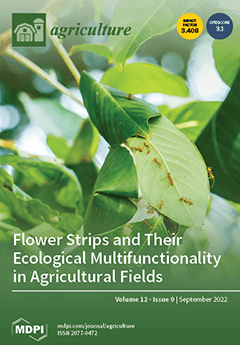This study aimed to evaluate the nutrient content and nutritive value of pruning waste of the Taif Damask rose for its potential use as an organic fertilizer or animal forage in the Taif region, Saudi Arabia. For this purpose, the pruning waste of Taif’s rose and soil samples supporting the plant growth at different ages were collected from four farms (F1: 4, F2: 10, F3: 12, and F4: 20 years old). The total aboveground biomass (AGB) of the plants, stems, and leaves were measured in addition to the stem height and crown diameter. The results showed that the maximum stem height and crown diameter (184.20 and 243.5 cm) were recorded in the oldest farm (F4). Moreover, the stem, leaves, and aboveground biomass (AGB) of the waste were maximal (3.91, 1.30 and 5.21 t ha
−1) at F4. F1 had the highest N content (154.30 mg kg
−1) in the plant leaves, while F2 had the highest stem N and P (172.33 and P 9.40 mg kg
−1). Moreover, F3 had the highest concentrations of leaf P (7.17 mg kg
−1), leaf and stem K (112.47 and 277.30 mg kg
−1), stem Ca
2+ (251.93 mg kg
−1), and leaf and stem Mg
2+ (122.27 and 123.57 mg kg
−1). The stems had higher percentages of total proteins, fibers, ash, and NFE (total carbohydrates) than the leaves in F1 and F2, while the opposite was observed in F3 and F4. The leaves of F2 rose plants had the highest percentage of neutral detergent fibers (NDF), and their stems had the highest percentages of total proteins (10.71%). The leaves of F3 plants had the highest percentage of acid detergent lignin (ADL) and the lowest crude fibers (7.63 and 13.27%), while the stems had the highest NFE (72.71%). The plant–soil relationship expressed by the CCA biplot showed that all the measured plant parameters were at higher positions on the Mg axis, except for the plant height and crown diameter, which were at low positions on the N and NO
3 axes, respectively. In contrast, Cl
−, NO
3−, HCO
3−, and SO
42− had high positive correlations with axis 1 and negative values with axis 2, while EC, the total P, and Ca
2+ had high positive correlations with, and pH had high negative values in relation to, axis 2. Due to its considerable high inorganic and organic nutrient contents, Taif’s rose could be used in the manufacturing of organic fertilizer. Additionally, the analysis of the nutritive value of the pruning waste supports its use as animal forage. We strongly recommend that further studies be conducted on the application of plant waste as a soil amendment and animal forage in the field.
Full article





